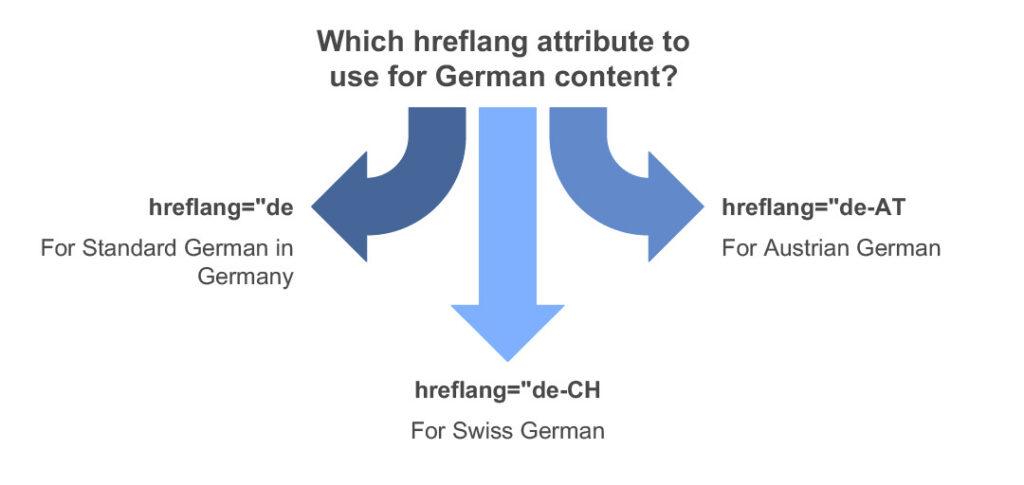In the ever-competitive landscape of search engine optimisation (SEO), technical SEO plays a pivotal role in ensuring a website’s visibility and performance.
While core technical SEO principles apply across markets, adapting them to specific regions can provide a significant edge.
In this article, we will explore the unique technical SEO considerations for German websites SEO.
From proper URL structures to hreflang tags, site speed, and mobile optimisation, these strategies will help you enhance your SEO efforts for the German-speaking audience.

Proper URL Structure for German Websites
One of the foundational aspects of technical SEO is URL structure. URLs should be clear, user-friendly, and reflect the page’s content accurately.
For German websites, however, there are unique language-specific considerations.

Best Practices for SEO-Friendly URLs
Using German Language in URLs:
It’s essential to keep your URLs in German when targeting the German market. Not only does this improve the user experience by reflecting the content in their native language, but it also enhances your site’s relevance in search engines.
For example, instead of using a generic URL like /insurance-services, it’s more beneficial to use /versicherung-dienstleistungen, which is aligned with German search terms.

Avoiding Special Characters:
German contains special characters like umlauts (ä, ö, ü), which can complicate URLs.
For SEO-friendly URLs, it’s advisable to avoid these characters. Instead, replace them with their simpler equivalents: ä becomes ae, ö becomes oe, and ü becomes ue.
For example, “Küche” (kitchen) would become “Kueche” in the URL. This prevents potential encoding issues and improves accessibility.

Keywords in URLs
Including German keywords in your URL structure is an important SEO tactic.
Google and other search engines use URLs as a ranking factor, so having relevant German keywords increases your chances of appearing in searches.
However, it’s important to avoid keyword stuffing, which can result in clunky and ineffective URLs.
A clean URL, such as /deutschland-reiseangebote, is much more impactful than a URL overloaded with unnecessary or repetitive terms.

URL Hierarchy and Structure
A logical, hierarchical URL structure is essential for both users and search engines.
German users prefer a clean and predictable structure, especially for e-commerce and large content websites. For example, using a structure like /produkte/haushaltsgeraete/waschmaschinen helps users navigate and also signals to search engines the relevance and relationship between different sections of the site.

Hreflang Tag Implementation for Multilingual Sites
For businesses that operate in multiple countries or offer multiple languages, the proper implementation of hreflang tags is crucial.
This is especially important for German websites with different versions targeting Germany, Austria, and Switzerland.
What Are Hreflang Tags?
Hreflang tags tell search engines which language and regional version of a webpage should be served to users based on their language or location.
By using hreflang tags, you prevent search engines from showing the wrong version of your site to users in different German-speaking countries, such as Austria or Switzerland.
Implementing Hreflang for German-Specific Pages
For German websites, you should be aware of the different language variants within German-speaking countries. For instance:
- Standard German spoken in Germany uses
hreflang="de". - Austrian German uses
hreflang="de-AT". - Swiss German uses
hreflang="de-CH".
These hreflang tags allow search engines to direct users to the most appropriate version of your content, reducing bounce rates and improving user experience.

Avoiding Duplicate Content
Without hreflang tags, search engines might index multiple versions of the same content (for example, a German version for Germany and an Austrian version for Austria), which can lead to duplicate content issues and affect rankings.
Implementing hreflang properly helps to ensure that the correct version of your site appears in the correct location, preserving your site’s SEO equity.

Common Mistakes to Avoid
Some of the common mistakes with hreflang include inconsistent tagging across different language versions, missing reciprocal hreflang references, or using the wrong language codes.
Ensure that every language page correctly references other versions, and always validate your hreflang setup with tools like Google’s Search Console.

Site Speed Optimisation for the German Market
Site speed has been a critical ranking factor for years, and it’s especially important in Germany, where users expect high performance and fast load times.
Google has continued to prioritise speed through Core Web Vitals, which measure load time, interactivity, and visual stability.

Importance of Fast Load Times in Germany
German users expect fast, reliable websites, and slow load times can drastically increase bounce rates.
to studies, a one-second delay in load time can lead to a 7% reduction in conversions. For German websites, this means that speed optimisation is not just a technical SEO factor; it’s essential for user satisfaction and business outcomes.
Optimising Core Web Vitals
To meet Google’s standards for site speed, you need to focus on the three key Core Web Vitals:
- Largest Contentful Paint (LCP): This measures how quickly the largest element on a page (such as an image or heading) becomes visible. A good LCP score is under 2.5 seconds.
- First Input Delay (FID): This tracks how quickly the site responds to the first user interaction. A score under 100 milliseconds is considered optimal.
- Cumulative Layout Shift (CLS): This metric assesses how stable the content is as it loads. Ensure that your page doesn’t shift around unexpectedly as it renders.
Practical Tips for Boosting Site Speed
Image Compression and Lazy Loading:
Images often contribute to slow load times. Use image compression tools like TinyPNG to reduce file sizes without compromising quality.
Implementing lazy loading ensures that images only load when they’re about to enter the viewport, reducing initial load time.
Minifying Code:
Minify your JavaScript, CSS, and HTML files by removing unnecessary whitespace, comments, and redundant code. This reduces the size of your pages and helps them load faster.
Content Delivery Network (CDN):
Using a CDN can drastically reduce load times by serving content from a server that’s geographically closer to the user.
This is particularly helpful for German websites targeting audiences in different parts of Europe.
Mobile Optimisation Strategies for German Users
With the majority of searches now happening on mobile devices, mobile optimisation is an essential part of technical SEO.
German users are no exception, and mobile-friendly sites are crucial to ensuring good user experience and SEO performance.
Mobile-First Indexing
Google’s shift to mobile-first indexing means that your website’s mobile version is the primary version that Google uses for ranking. For German websites, this means that if your mobile experience is poor, your rankings will suffer, regardless of how good your desktop version is.
Design Considerations for German Mobile Users
Responsive Design:
Ensuring that your website is fully responsive is no longer optional.
Responsive design automatically adjusts your site’s layout based on the device’s screen size, offering a consistent experience for users across mobile, tablet, and desktop.
Mobile Navigation:
German users expect intuitive navigation on mobile. Ensure that your navigation menus, buttons, and call-to-action (CTA) buttons are optimised for touch interaction.
The layout should be clean, with minimal clutter, to avoid frustrating the user.
AMP (Accelerated Mobile Pages)
AMP pages are a stripped-down version of your site’s content, designed to load instantly on mobile.
While AMP isn’t essential for every German website, it’s a good option for news publishers and sites where speed is critical. AMP pages can boost performance on mobile by significantly reducing load times.
Testing and Monitoring Mobile Performance
Mobile-Friendly Tests:
Regularly run mobile-friendly tests on Google’s Mobile-Friendly Test tool to ensure that your website meets all requirements for mobile optimisation.
Optimising for 4G/5G:
With Germany’s expanding 5G network, ensure that your site is optimised for both 4G and 5G speeds. This means reducing data-heavy elements and ensuring smooth performance on all devices.
Conclusion
Technical SEO is a critical factor for ensuring the success of any German website. Proper URL structure, hreflang tag implementation, site speed optimisation, and mobile-friendly design are essential components that contribute to higher search rankings and better user experiences.
By paying close attention to these technical SEO considerations, you can ensure that your German website not only meets but exceeds the expectations of both search engines and users.
As the digital landscape evolves, staying on top of technical SEO best practices will be key to maintaining visibility and competitiveness in the German market.




